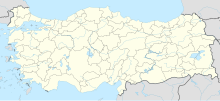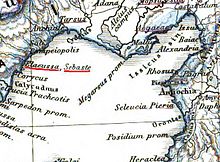Elaiussa Sebaste
Coordinates: 36 ° 29 ′ 1 ″ N , 34 ° 10 ′ 25.4 ″ E
Elaiussa Sebaste is an ancient city and temporary royal residence on the coast of Cilicia , near today's village Ayaş , around 30 km east of Silifke in the Turkish province of Mersin . In the west it borders directly on ancient Korykos , today's Kızkalesi .
Location of the city
Little is known about the pre-Roman history of the place, it is first mentioned in the early 1st century BC. The original core of the city was on an island directly on the coast, which silted up early. Elaiussa Sebaste's development was encouraged by its convenient location on the coastal road that linked Asia Minor with Syria in ancient times and the city's inclusion in the region's intensive trade. The extensive forests in the hinterland as suppliers of wood and the cultivation of wine and olives (Greek elaion ), which the name of the place probably alludes to, were economically important for this .
Temporary royal residence
20 BC The Roman Emperor Augustus expanded the empire of the Cappadocian clientele King Archelaos I to include part of the mountainous regions of Cilicia. The acquisition of the Cilician coastal strip was the reason for Archelaus to move his residence from the Cappadocian Mazaka to the (much more pleasant and more accessible for travelers) Cilician island of Elaiussa, where he had a palace built. Archelaos renamed the place "Sebaste" in honor of Emperor Augustus (after Sebastos , the Greek form of Augustus). Archelaus also received state guests in his palace in Elaiussa-Sebaste, including his brother-in-law, King Herod the Great of Judea .
In 38 AD the city fell to Antiochus IV of Commagene . Since 72 AD, Elaiussa belonged to the Roman province of Cilicia.
The city began to decline in the 3rd century, especially when it was conquered by the Sassanids in 260. In late antiquity , it is documented as a diocese and probably continued until the Arab invasion .
Preserved ancient buildings
A theater, the agora , on which a church was built in late antiquity, a Roman temple that was converted into a church, a large late antique rotunda with a portico at the harbor, remains of aqueducts and thermal baths are well preserved . There are numerous, very well-preserved necropolises on the streets in the vicinity of the city . A few kilometers inland is the town of Kanytelleis, which temporarily belongs to Elaiussa . About seven kilometers east of the sea lies the ruins of Akkale , which is believed to be a palace and associated buildings. It is commonly seen in connection with Elaiussa Sebaste.
East apse of the basilica
Excavations
Italian archaeologists from La Sapienza University in Rome have been digging in Elaiussa Sebaste since 1995, under the direction of Eugenia Equini Schneider .
literature
- Ernst Kirsten : Elaiussa-Sebaste in Cilicia . In: Mansel'e Armağan - Mélanges Mansel . Ankara 1974, Vol. 2, pp. 777-802.
- Alois Machatschek : The necropolis and tombs in the area of Elaiussa Sebaste and Korykos in the rough Cilicia . Böhlau, Vienna 1967.
- Eugenia Equini Schneider (Ed.): Elaiussa Sebaste . Bretschneider, Rome
- Campagne di scavo 1995-1997 . 1999, ISBN 88-8265-032-4 .
- Un porto tra Oriente e Occidente . 2003, ISBN 88-8265-257-2 .
- L'Agora Romana . Ege Yayinlari, Istanbul 2010, ISBN 978-605-5607-21-0
- Theodora Stillwell MacKay: Elaeussa later Sebaste (Ayaş) Rough Cilicia, Turkey . In: Richard Stillwell et al. a. (Ed.): The Princeton Encyclopedia of Classical Sites. Princeton University Press, Princeton NJ 1976, ISBN 0-691-03542-3 .
- Eugenia Equini Schneider: Elaiussa Sebaste. A Port City between East and West. An archaeological guide . ( Homer Archaeological Guides 8) Homer Kitabevi, Istanbul 2008, ISBN 978-9944-483-23-0
Web links
Individual evidence
- ^ Schneider, Elaiussa Sebaste, 2008, p. 8.
- ↑ Flavius Josephus : Antiquitates Judaicae 16, 4, 6.









